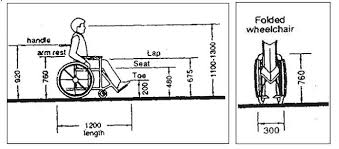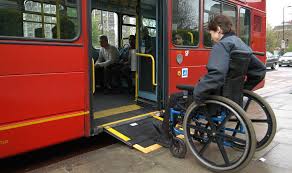Accessibility Guidelines for Bus terminals and Bus Stops – Government of India MINISTRY OF ROAD TRANSPORT & HIGHWAYS.
Mobility Devices and Space Allowances
Persons with Disabilities use several devices to overcome the specific conditions. Therefore, anthropometrics is used to ensure that dimensions in a building such as doors, doorways, passenger areas, reception desks, rest areas, relationship between desk and wheelchair, toilets are designed appropriately. Adequate space should be allocated for persons using mobility devices, e.g. wheelchairs, crutches and walkers, white cane etc. as well as those walking with the assistance of other persons.

more details about mobility devices and space allowances
Bus Terminal Exteriors including Parking Areas
Bus terminal Exteriors and Parking Area – Approach to Building, Passenger alighting and drop off points, Access to building, Floor surfaces, Floor surfaces, Walks and Paths, Lighting for walkways, Car Parking and Taxi/Auto Rickshaw Stands
more details about Bus terminal Exteriors and Parking Area
Bus Terminal Interiors
The guideline intended to be a convenient resource that can be used to enhance the accessibility of specific bus stops, or help in the development of a strategic plan to achieve system-wide accessibility.
more details about Bus Terminal interiors
Toilets
Signage at accessible toilet entrance should be clearly visible and should comply with the International Symbol of Accessibility.
more details about Toilets
Fire Evacuation Needs
Provision of accessible means of egress from all public use areas and facilities is as vital a component as accessible ingress.
more details about Fire evacuation needs
Signage
Signs are important to people who are unfamiliar with their surroundings. They are to provide information. They can inform the user of a route, a hazard, or a facility.
more details about Signage
Road Crossings
- Pedestrian crossings should be equipped with traffic control signal;
- Constructing traffic islands to reduce the length of the crossing is recommended.
- Guide strips should be constructed to indicate the position of pedestrian crossings for the benefit of people with visual impairments;
- Road bumps are helpful in reducing the speed of traffic approaching the intersection.
more details about Road Crossings
Bus stop
Bus stops should be located adjacent to the bus linear line of travel so that the bus does not need to pull over to the left. It is recommended to place the bus stop at the far side of the intersection than the near side.
more details about Bus Stop
Buses and Service Providers
Buses, trams, taxis, mini-buses and three-wheelers should be designed as far as practicable to include facilities that can accommodate people with disabilities
more details about Buses and Service Providers
Checklist for pre-Commissioning
A comprehensive checklist is given below to review the accessibility of infrastructure and facilities created, before commencement of operations, for ready reference.
more details abut checklist
Download
Accessibility Guidelines for Bus terminals / Bus stops – MORTH
